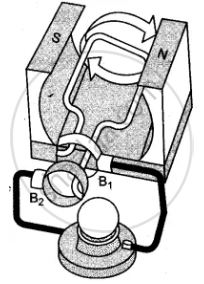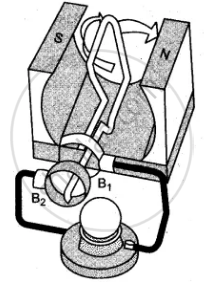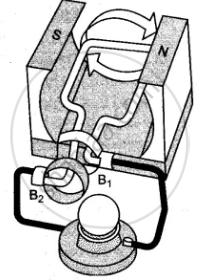Advertisements
Advertisements
प्रश्न
The device used for producing electric current is called a ______.
विकल्प
generator
galvanometer
ammeter
motor
उत्तर
The device used for producing electric current is called a generator.
Explanation:
- A generator is a device that transforms mechanical energy into electrical energy.
- A galvanometer is a device that detects the existence of electricity in a circuit.
- An ammeter is a device that measures the amount of electric current flowing across a circuit.
- A motor is a piece of machinery that turns electrical energy into mechanical energy.
As a result, the generator is the correct solution.
APPEARS IN
संबंधित प्रश्न
Name some sources of direct current.
Which sources produce alternating current?
Name the device which converts mechanical energy into electric energy.
What type of generator is used at Power Stations?
What is the function of brushes in an electric generator?
What is the major difference between the simple alternator and most practical alternators?
Why are Thermal Power Stations usually located near a river?
Complete the following sentence:
A generator with commutator produces ............... current.
Draw the labelled diagram of an A.C. generator. With the help of this diagram, explain the construction and working of an A.C. generator.
An electric generator converts:
(a) electrical energy into mechanical energy.
(b) mechanical energy into heat energy.
(c) electrical energy into chemical energy.
(d) mechanical energy into electrical energy.
A d.c. generator is based on the principle of:
(a) electrochemical induction
(b) electromagnetic induction
(c) magnetic effect of current
(d) heating effect of current
The frequency of alternating current (a.c.) supply in India is:
(a) 0 Hz
(b) 50 Hz
(c) 60 Hz
(d) 100 Hz
State whether the following statement are true of false:
A miniature circuit breaker (MCB) works on the heating effect of current.
Name and state the principle of a simple a.c. generator. What is its use?
What energy conversion does take place in a generator when it is in use?
Explain the construction and working of the following. Draw a neat diagram and label it.
Electric Generator (AC)
Explain the difference:
AC generator and DC generator.
An a.c. generator changes the ______energy to ______ energy.
Explain the construction and working of an electric generator (AC) with the help of a neat diagram.
State change that you would make to convert an A.C. generator into a D.C. generator. Illustrate the change by a diagram.
The given figures 1 to 3 show the working of a simple A.C. generator. Study the diagrams and answers of the following questions.



(i) State and explain the principle underlying the working of a simple generator.
(ii) Where is the loop of wire placed?
(iii) What happens when the loop is rotated?
(iv) Indicate the direction of the current flow through the wire for the first half of the turn (in first figure). Name and state the rule used in finding the direction of the current.
(v) Indicate the direction of the current for the case shown in second figure.
(vi) Indicate the direction of current in the outer circuit (i.e., electric bulb) in first and third figure.
(vii) What type of current is shown in the above diagrams? Explain.
A device for producing electric current is ______.
Draw and label the diagram of an AC generator.
To convert an AC generator into DC generator ____________.
A coil of insulated copper wire is connected to a galvanometer. What will happen if a bar magnet is withdrawn from inside the coil?
A coil of insulated copper wire is connected to a galvanometer. What will happen if a bar magnet is held stationary inside the coil?
